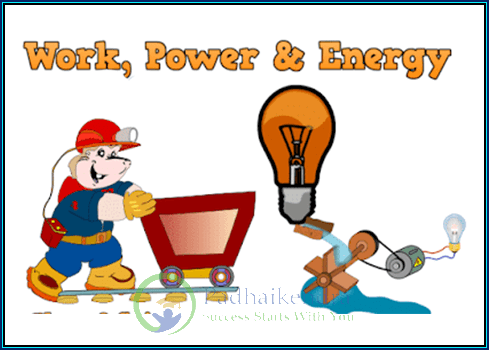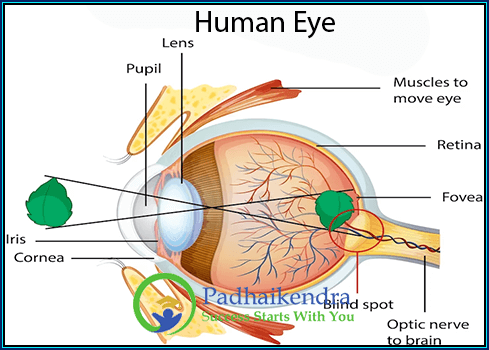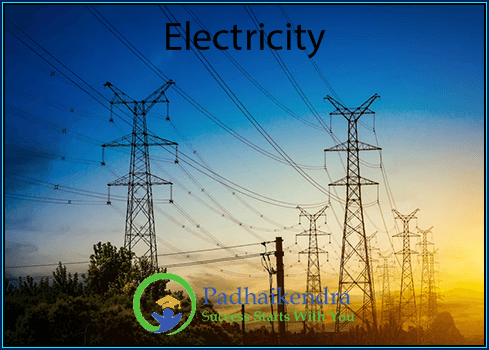Introduction to Work, Energy, and Power-
Every day, whether we realize it or not, we encounter the principles of work, energy, and power. When we push a door open, lift a heavy box, or even charge our mobile phones, we’re stepping into the world of work, energy, and power.
Work: Think of work as the effort put into making something move or change. For instance, when you use force to push a stalled car, you’re doing ‘work’ on the car.
Energy: Energy is like the invisible fuel that powers actions. It’s the reason we can move, light bulbs can glow, and machines can operate. In our body, the food we eat provides us with the energy to go about our day. In machines, it’s electricity or fuel that gives them the necessary energy.
Power: Imagine two people: one lifts a bucket of water to the roof in 10 seconds, while the other takes 30 seconds to do the same task. Here, both did the same work, but the first person was more powerful because they did it faster. So, power is about how quickly work is done or energy is used.
Work-
When we hear the word “work,” we often think of jobs, tasks, or chores. But in the world of physics, “work” has a special meaning. In simple terms, work is what happens when a force (like a push or pull) makes something move.
Definition and Mathematics of Work:
Imagine you’re pushing a box across the floor. Two things matter here: the force you’re using to push and how far the box moves. The work done is the combination of these two. If you push harder, more work is done. If the box moves farther, again, more work is done.
Work Formula:
Work can be calculated using a simple formula: Work = Force x Distance. So, if you apply a force to move something over a distance, you multiply the two together to get the work done.
Work Unit:
In science, we use a unit called “Joule” (abbreviated as ‘J’) to measure work. It’s like using kilograms to measure weight or kilometers to measure distance. So, when someone says they did 50 Joules of work, it gives a precise measure of the effort.
Work Example: Let’s say you’re pushing a shopping cart. If you apply a force to push the cart 10 meters and that force is equal to 5 Newtons (a unit to measure force), then the work you’ve done is 50 Joules (because 5 Newtons x 10 meters = 50 Joules).
Work as Area Under Curve:
This might sound fancy, but think of a graph where one side shows the force you apply and the other side shows the distance the object moves. The “area” or space underneath the graph’s curve shows the total work done. It’s a visual way to understand work.
Work and the Work-Energy Principle:
Here’s a cool connection: The work you do on something is directly related to the energy change in that thing. If you push a toy car and it starts moving, the work you did has been converted into the car’s movement energy.
Work as Transfer of Energy:
When you do work on an object, you’re essentially giving it energy. Like winding up a toy car. The effort you put in (work) is transferred to the car, which it then uses to zoom across the floor (energy).
Energy-
Have you ever wondered what makes a windmill turn or why a stretched rubber band snaps back when released? Behind all these actions is a magical entity called “energy.” It’s the invisible force that powers everything, from our movements to the brightest stars in the sky.
Different Types of Energy
Potential Energy:
Think of this as “stored” energy. A stretched rubber band or a ball held up high has potential energy because once released, the band snaps or the ball falls. It’s energy waiting to be used.
Kinetic Energy:
This is the energy of movement. A moving car, a rolling ball, or even you, when you’re running, all have kinetic energy.
Thermal Energy:
This relates to heat. When you touch a hot cup of tea or feel the warmth of the sun, you’re experiencing thermal energy.
Mechanical Energy:
This is the total of potential and kinetic energy in an object. For example, when you swing a pendulum, it has potential energy at its highest point and kinetic energy as it swings down.
Unit of Energy:
Just like we measure distance in meters or weight in kilograms, we measure energy in “Joules” (abbreviated as ‘J’).
Different Forms Energy
Gravitational Potential Energy:
Objects get this energy because of their position in relation to the Earth. A book on a high shelf has gravitational potential energy because it can fall down.
Spring Potential Energy:
This is the energy stored in a stretched or compressed spring. It’s based on Hooke’s Law, which says the force needed to stretch or compress a spring is directly proportional to the distance it’s stretched or compressed.
Conservation of Energy:
One of the coolest things about energy is it can’t be created or destroyed, only transferred or changed from one form to another. This idea is known as the “Conservation of Energy.” For instance, when you eat, your body transforms the food’s energy so you can move and think.
Thermal Energy:
This can come from various sources, including friction. When you rub your hands together quickly, they warm up. That’s because the action (friction) produces thermal energy.
Elastic and Inelastic Collisions:
Imagine two toy cars crashing. In an elastic collision, they bounce off each other, retaining most of their energy. In an inelastic collision, they might stick together, losing some of their movement energy but not their overall energy.
Power-
Have you ever noticed some gadgets charge faster than others? Or wondered why some cars accelerate faster than others? Behind these observations is a concept called “power.”
What is Power?
Imagine two friends racing. Both cover the same distance, but one finishes way quicker. While both did the same “work” (they ran the same distance), the faster friend demonstrated more “power.” Simply, power is the speed at which work is done or energy is used.
Power Formula:
Just as speed is distance over time, power is work over time. Mathematically, Power = Work/Time. So, if you do a lot of work in a short amount of time, you have more power.
Power Unit:
We measure power in “Watts” (abbreviated as ‘W’). When you look at a light bulb and it says “60W,” it’s telling you the bulb uses energy at a rate of 60 Joules per second.
Power Example:
Let’s use the light bulb again. A 60W bulb uses energy faster than a 40W bulb. This is why the 60W bulb is brighter. It’s showing its “power” by using more energy in the same amount of time.
Power and Efficiency:
Think of a car’s engine. Two cars might have engines of the same power, but one might use less fuel. This car is more “efficient.” It’s getting more out of the energy it uses. So, power isn’t just about being fast or strong; it’s also about how wisely you use your energy.
Simple Explanation: Power is all about the pace: how quickly work gets done or energy gets used. Whether we’re charging gadgets, driving, or even just turning on a light, power plays a big role in our daily lives.
Comparisons and Distinction-
These three terms – work, power, and energy – often come up in science and our daily lives. While they’re related, they each have distinct meanings.
Work vs. Power
Think of “work” as the effort you put into a task, like pushing a heavy box across a room. “Power,” on the other hand, is about how quickly you do that task. If you push that box across the room in 5 seconds versus 20 seconds, you’ve displayed more power in the first case.
Simple Explanation: Work is what you do; power is how fast you do it.
Work vs. Energy
“Work” is the action you take when you apply force to an object and move it. “Energy” is the capacity or ability to do that work. Imagine a charged battery; it has the energy or potential to power a device. When you use it in a toy car and the car moves, that’s the work being done.
Simple Explanation: Work is the action, while energy is the potential to perform that action.
Power vs. Energy
“Power” is the rate at which work is done or energy is used. If you have two identical batteries and one discharges in 2 hours while the other takes 5 hours, the first battery is delivering power more quickly, even if both provide the same total energy. “Energy” is the total amount of work that can be done by a system.
Simple Explanation: Power is about speed, while energy is about capacity.
Real-world Scenarios-
Every day, things around us move, change, and interact. Behind these actions are forces and energy at play. Let’s delve into some real-world scenarios to understand these concepts better.
The Battle of Internal vs. External Forces
Imagine you’re holding a rubber ball and you squeeze it. The ball resists and tries to regain its shape. This resistance? That’s an “internal force.” It comes from within the object itself. Now, the force you use to squeeze the ball? That’s an “external force” because it’s applied from outside.
Simple Explanation: Internal forces are like an object’s personal rules, determining how it behaves on its own. External forces are influences from the outside world that can change an object’s state.
Situations Involving External Forces
Think of a football game. When a player kicks the ball, it moves. That kick? It’s an external force. Depending on the force’s strength (like a gentle tap or a strong kick) and direction, the ball will move differently. Other external forces like wind or even friction from the grass will further affect its movement.
Simple Explanation: External forces are the pushes, pulls, and influences from the outside that determine how an object moves or changes.
Conserving Mechanical Energy
“Conservation of Mechanical Energy” sounds complicated, but it’s a basic idea. In some situations, the total amount of moving and stored energy (called kinetic and potential energy) remains the same. It just switches between the two types.
Example: Picture a swing. At its highest point, it has the most stored (potential) energy. As it swings down and moves fastest at the bottom, this stored energy converts to moving (kinetic) energy. But, the total energy? It stays the same; it just changes forms.
Simple Explanation: Mechanical energy conservation is like a see-saw. The total weight (or energy) stays the same; it just shifts from one side to the other.
Important Resources and Formulas-
Diving into topics like work, energy, and power can be intriguing. But to truly grasp them, it’s essential to have the right tools at your disposal. Let’s explore the resources and formulas that act as our toolkit.
Work, Energy, and Power Formulas
Formulas are like recipes in cooking. They give us a step-by-step method to find out certain values or understand relationships between different factors.
Work = Force x Distance
Power = Work/Time
Kinetic Energy = 0.5 x Mass x Velocity^2
Work Done by Constant Force
If a force F acts on a body at an angle θ and displaces the body through a distance ‘S’, work done is-
W = F x d
W = (F cos θ) d
Work Done by Multiple Forces
Work done on a body is the sum of the individual work done by all the forces acting on the particles.

W = W1 + W2 + W3 +….
Kinetic Energy Formula
Kinetic energy is a scalar quantity. Kinetic energy for a body is the work it can accomplish just by moving.
![]()
Power Formula
The rate at which work is performed is defined as power-
P = W/t
Where,
P = Power
W = Work done
T = Time taken
Work-Energy Theorem
Work-energy theorem states, a particle’s change in kinetic energy is equal to the work that the net force does on it.
W= ∆K
Mechanical Energy Formula
Kinetic energy and potential energy add up to the mechanical energy of an object.
E= K + U
Potential Energy Formula
Potential Energy is the energy that a body produces as a result of its location or state.
Potential Energy = mgh
Fun Facts-
Science isn’t just about equations and experiments; it’s full of surprises and intriguing facts that make the learning journey captivating. Let’s uncover some of the fascinating aspects of work, energy, and power-
The World’s Most Powerful Lift: The Burj Khalifa in Dubai, known as the tallest building globally, has elevators that move at a speed of up to 10 meters per second!
Human Power: Believe it or not, while sprinting, Usain Bolt has generated over 2,000 watts of power. That’s enough to power up a microwave!
Nature’s Battery: Electric eels use energy in their bodies to produce electric shocks. These can be as powerful as 600 volts, enough to knock a horse off its feet!
Machines and Efficiency: Consider a car engine. It converts fuel (its energy source) into movement (doing work). But not all the energy from the fuel goes into moving the car. Some might be lost as heat. So, the car’s efficiency would be how much of the total energy is used for movement compared to what’s lost.
Simple Explanation: Efficiency is like the report card of machines. It tells us how well they use their energy to do work. It’s about getting the best results with the least waste.
FAQs-
Que. What is work?
Sol. Work is defined as the transfer of energy that occurs when a force is applied to an object, causing it to move in the direction of the force. It is calculated as the product of the applied force and the displacement of the object in the direction of the force.
Que. What is energy?
Sol. Energy is the capacity to do work or the ability to cause changes in objects or systems. It exists in various forms such as kinetic energy (energy of motion), potential energy (energy stored due to position or configuration), thermal energy, chemical energy, and more.
Que. What is the relationship between work and energy?
Sol. Work and energy are closely related concepts. When work is done on an object, it transfers energy to that object, either increasing its kinetic energy or potential energy. Similarly, when work is done by an object, it transfers energy from the object, decreasing its energy.
Que. What are the different forms of energy?
Sol. There are several forms of energy, including kinetic energy (associated with motion), potential energy (associated with position or configuration), thermal energy (related to temperature), chemical energy (stored in chemical bonds), electrical energy (resulting from the movement of electrons), and many more.
Que. What is power?
Sol. Power is the rate at which work is done or the rate at which energy is transferred or transformed. It is calculated as the amount of work done divided by the time taken to do the work. The unit of power is the watt (W).
Que. How is power related to work and time?
Sol. Power is directly related to both work and time. The formula to calculate power is- Power = Work / Time. It means that the more work done in a given amount of time, the higher the power.
Que. What are some examples of work and power in everyday life?
Sol. Examples of work and power in everyday life include lifting heavy objects, running, climbing stairs, operating machines and appliances, and even typing on a keyboard. In each case, energy is expended, work is done, and power is involved.
Que. Can work be negative?
Sol. Yes, work can be negative. When the force applied to an object is in the opposite direction to the displacement of the object, the work done is negative. This happens when the force opposes the motion or when an object is lowered under the force of gravity.
Que. How does the conservation of energy apply to work and power?
Sol. According to the principle of conservation of energy, energy cannot be created or destroyed; it can only be transferred or transformed. In the context of work and power, this means that the total amount of energy involved in a system remains constant, even if energy is transferred from one form to another.
Que. How can understanding work, energy, and power be useful in everyday life?
Sol. Understanding work, energy, and power can be useful in various aspects of everyday life. It helps in optimizing tasks and processes, managing energy consumption, designing efficient systems, and making informed decisions regarding energy use and conservation. Additionally, it provides a foundation for understanding concepts in physics and engineering.





